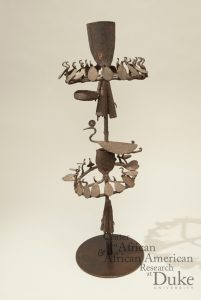
Opa Osun
My research will be centered on the Opa Osun staff of fate, an artifact that represents the destiny of an Orisha worshipper. A staff of this nature is commonly placed in front of one’s home to enrich the life of its owner. Composed of mostly iron, the staff is approximately 30 inches tall and 10 inches in diameter. The staff must always remain upright; placing the object horizontally on the ground is considered to be an act of ill will specifically felt by the owner. The object itself consists of two levels that resemble the ring around Saturn. On each level there are many small birds circling the stalk of the staff, however the lower level differs because it contains a large bird surrounded by the smaller ones. Birds are critical to Yoruba culture for they are associated with the importance of the head. By focusing on the object in context, I would like to reveal whether or not the object was placed in front of an Orisha follower’s home, and how it has become a museum artifact. In addition to this, I hope my findings allow me to learn if the staff is still activated in the sense that the same rules apply when it was utilized by its owner.
The elements of Yoruba culture that give the Opa Osun meaning have been discussed in several readings covered in the course curriculum. “Ase: Verbalizing and Visualizing Creative Power through Art”, presented by Professor Abiodun, discusses the vital force of Ase. Ase is said to be present in all facets of Yoruba art, including objects such as staffs. Analyzing the essence of Ase from the reading will give insight to the question of whether or not the Opa Osun is still activated in the context of the museum. If the staff does in fact remain activated, the measures that are taken to prevent foul placement will be detailed. The Opa Osun contains visual sculpted birds, which are emphasized in Yoruba culture because a bird’s head is the front facing part of its body. The critical role of the head is explained in “Yoruba World”. “It is the site of one’s spiritual essence, the place through which divine forces enter during possession trance, and a kind of visible oriki conveying a person’s dignity and pride in positive achievement” (Drewal, Pemberton, Abiodun 15). By analyzing the prominence of one’s head in the reading it is hoped to reason why birds were incorporated in a staff that represents the fate and destiny of its owner.
In order to learn more about the origin of the Opa Osun staff in the exhibit, I will enlist help from the library staff to possibly find reports of similar staffs in Nigeria. By doing so I hope to find the region where this staff was located which will help me determine if the staff once belonged to a practitioner and was misplaced. Another source I intend to use to further understand the questions put forth will be articles that include iron staffs in Yoruba culture and the treatment by owners to prevent ill will. Using the library’s Gale database tool, I will be able to focus on peer reviewed scholarly journals relating to the topic. Another potential resource I can use to answer my questions is some sort of film that incorporates the pertinence of birds in Yoruba culture. A film or documentary that explicitly describes the concept of the larger bird surrounded by lesser birds is preferred to benefit my understanding of the Opa Osun staff.